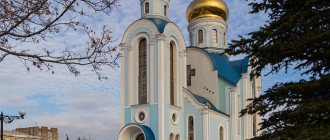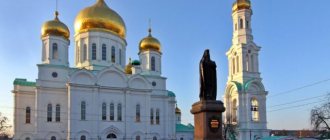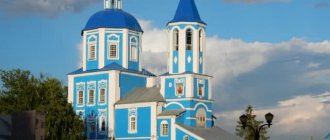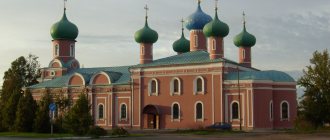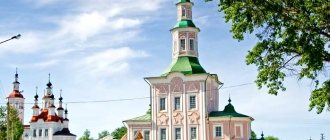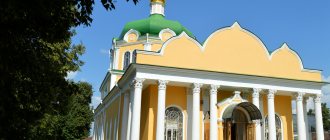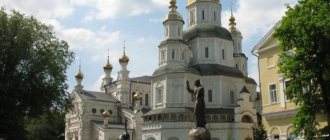| Tula Assumption Cathedral. Photo by Denis Kabanov, 2000s. |
Tula and Ephraim Diocese
of the Tula Metropolis of the Russian Orthodox Church
- Diocesan administration: Russia, 300000, Tula, st. Zhukovsky, 61
- Tel.: (4872) 36-39-95, 31-24-60, 36-15-07
- Official site:
- Canonical territory: Bogoroditsky, Venevsky, Volovsky, Efremovsky, Kimovsky, Kireevsky, Kurkinsky, Leninsky, Uzlovsky districts; Tula, Novomoskovsk, Donskoy GO, Tula region.
- Cathedrals: Assumption (Kremlin) in Tula, All Saints in Tula, Assumption “Black” (former monastery) in Tula, Church of the Icon of the Mother of God “Seeking the Lost” in Efremov
- On the map: Yandex.Map, Google map
Background
In 1261, Metropolitan Kirill III established the Sarai diocese, which, with the weakening of the khan’s power, was transferred by Bishop Vassian around 1460 to Moscow to “Krutitsy,” which was called Krutitskaya.
Since 1350, this diocese has been in charge of the western part of the Tula province with the cities of Novosil, Odoev, Belev and Cherny. Another part of the Tula cities was ruled by the Ryazan bishops for 415 years (from 1207 to 1622). This division of the cities of the Tula region between the Ryazan and Krutitsa dioceses was finally approved by St. Metropolitan Alexy around 1360, giving the Ryazan diocese the lands on the left, and the Krutitsa diocese the lands on the right side of the Don River [1]. Thus, Tula, Venev and other cities, except for Aleksin, which belonged to the Moscow Metropolitanate, and Kashira, which belonged to the Kolomna diocese, became dependent on the Ryazan diocese, which was consistent with the boundaries of civil administration, which then covered almost the entire northeastern part of the Tula province belonged to the Ryazan principality. In 1622, Patriarch Filaret (Romanov) transferred the cities of the future Tula province: Aleksin, Tula, Dedilov, Gremyachev and Epifan to the Kolomna diocese, to which Old Kashira, located on the Moscow side - the left bank of the Oka River, had long belonged, which is why the bishops of Kolomna from the time of its establishment before the abolition of the Kolomna diocese they were called Kolomna and Kashirsk. Kashirsky district, located on the Tula side - the right bank of the Oka River, belonged to the Ryazan department. By the definition of the Moscow Council of 1674, it was given to the Kolomna diocese in 1675, and in return the cities of Gremyachev and Epifan with their counties were returned to the Ryazan department. At the same time, the city of Venev was transferred to the Kolomna diocese from Ryazan, and the city of Bogoroditsk, built in 1622, was transferred to the Ryazan diocese from Kolomensk, about the rights to which there was a dispute in 1675 between the Kolomna and Ryazan dioceses [2].
In 1682, Patriarch Joachim intended, having separated Tula from Kolomna, to establish new episcopal departments in Tula, as well as in Belyov and Kashira, with their subordination to the Moscow patriarchal throne [3], but due to the death of Tsar Feodor Alekseevich and the Streltsy rebellion that happened at the same time The patriarch's assumption could not come true.
The Tula Church, in addition to subordination to the above three dioceses, was partially dependent on other dioceses: the city of Efremov from 1764 to 1767 was expelled from the Kolomna diocese to Voronezh, where it was under the control of St. Tikhon; in 1774, the city was transferred from the Krutitsk diocese to the Voronezh diocese. Novosil.
In 1777, the Tula governorship was opened, which included cities that until that time belonged to different provinces: Tula, Aleksin, Belev, Venev, Odoev, Kashira, Krapivna, Epifan, Chern, Efremov, Novosil, Bogoroditsk and those left without a district - Dedilov and Gremyachev. In 1788, according to the decree of Tsarina Catherine II, given on May 6 to the Holy Synod with the aim of bringing the divisions of the boundaries of the dioceses, if possible, in accordance with the boundaries of the provinces, it was ordered: 1) there should be no Krutitsa diocese, and the Kaluga province should be annexed to the Moscow one; 2) at the end of the war, establish a bishop's house in Tula, and include the Tula viceroyalty in the Kolomenskaya diocese, naming its bishop, the newly installed Afanasy (Ivanov), Kolomensky and Tula.
In 1797, the Tula governorate was transformed into a province.
Establishment in 1799
Catherine II's idea of establishing a special episcopal department in Tula for the Tula province was carried out during the reign of Paul. By a decree of July 31, 1799, he ordered the Holy Synod: “In general, to distribute the department of each in all dioceses according to the boundaries of the provinces, and the very names of the dioceses, for greater uniformity, to change according to the rank of those provinces in which their departments are located” [4]. As a result of this decree, the Synod drew up a report on the relocation, renaming and establishment of new episcopal departments, according to the boundaries of the provinces. According to this report, Bishop Kolomensky, whose department included all the churches of the Tula province, as well as part of Moscow and Ryazan, with the latter being assigned to their dioceses, was to manage only the churches of the Tula province and transfer the department itself to the city of Tula, to the Forerunner Monastery, which convert to the bishop's house, the bishops of the new see are called Tula and Belevsky. On October 16, this report was approved, and on December 19, by decree of the Holy Synod, the Bishop of Kolomna, His Eminence Methodius, was ordered to send from the Kolomna Consistory the affairs relating to the churches that had departed from his diocese, and, having made an inventory of the cathedral, buildings and churches of the Kolomna bishop's house, he handed them over to the abbot of the Golutvin Monastery, and he himself, taking the sacristy, utensils and household property necessary for the episcopal rank, as well as singers and necessary servants of the bishop’s house, proceeded to the city of Tula, where the seminary and consistory were to be transferred.
The establishment of the episcopal see in Tula was beneficial for the entire Tula province, since this was accompanied by the opening of a seminary and consistory in Tula, which created convenience for the clergy of the diocese when appealing to the ruling bishops and the consistory, as well as in teaching children in the seminary, which was previously extremely inconvenient due to the remoteness of more than half of the Tula province from the Kolomna diocese.
From 1922 to 1944 there was a renovationist diocese of the same name.
Formation of the metropolis
On December 27, 2011, the independent Belevsky diocese was separated from the Tula diocese, and both dioceses were included in the newly formed Tula Metropolis. The Bogoroditsky, Venevsky, Volovsky, Efremovsky, Kimovsky, Kireyevsky, Kurkinsky, Leninsky, Uzlovsky districts, as well as the Tula, Novomoskovsky and Donskoy urban districts in the east of the Tula region were left under the jurisdiction of the Tula department.
Historical names
- Tula and Belevskaya (1799 - 1919)
- Tula and Venevskaya (1919 - 1920)
- Tula and Odoevskaya (1920 - 1944)
- Tula and Belevskaya (1944 - December 27, 2011)
- Tula and Efremovskaya (since December 27, 2011)
Statistics
- 1912 - Churches - 916, chapels and houses of worship - 141; Monasteries - 9 (5 women's), 1 women's community, 1 monastery courtyard; Theological seminary, 4 theological schools, 1 diocesan women's school, 1013 church schools; Church libraries - 889; Hospitals - 9, almshouses - 38.
- January 1, 1958 [5] - 40 registered temples/houses of worship.
- OK. beginning 2008 - 152 parishes, 8 monasteries (4 women’s and 4 men’s) [6].
- December 1, 2011 - monasteries - 9, monastics - 43; parishes - 155, white clergy - 230 [7].
With the arrival of the Bolsheviks, the fight against religion began: parishes and churches were closed
This was the most difficult period for the Russian Orthodox Church. Temples, monasteries, and religious institutions were destroyed. There was a forcible confiscation of church valuables.
With the establishment of Soviet power, almost all churches in the diocese were closed.
The church revival began during the period of perestroika under Metropolitan Serapion (Fadeev). The number of operating temples increased. The churches of the Tula diocese were restored and updated.
Metropolitan of Tula and Belevsky Serapion (Fadeev). During his ministry, the Tula diocese flourished
The diocese reached great prosperity during the reign of Serapion. Pastoral courses appeared, a theological school began to operate, which later received the status of a seminary. Metropolitan Serapion gave his blessing to the creation of an Orthodox classical gymnasium.
During the years of his ministry, the fight against sectarianism was intensified.
In 1998, an important event took place in the life of the diocese - the revival of the vicariate. Bishop Kirill of Theotokos was elected vicar, and in 2000 he became the ruling bishop.
Since 2002, the Tula See was headed by Archbishop Alexy of Astana. Through the efforts of the Bishop, much has been done to restore ancient churches and organize parish and cultural life.
Story
Christian preaching has been carried out on Tula soil for more than 900 years. Active missionary activity on the territory of the modern Tula diocese began at the end of the 11th century. from the conquest of these lands by the Chernigov princes. The Vyatichi tribe resisted Christianization for a long time. The remnants of the tribe living in the area of the city of Mtsensk were converted to Orthodoxy at the beginning of the 15th century.
Until the middle of the 13th century. the lands of the Vyatichi were under the control of the Chernigov and Ryazan bishops. In 1261, with the blessing of Metropolitan Kirill, the Sarai diocese was created, which included all the southern Russian lands between the Volga and Dnieper. Its first head was Saint Mitrofan of Pereyaslavl.
Mother of God Nativity Monastery in the Tula region
Due to the weakening of the Horde, in 1460 Bishop Vissarion moved his see to the Moscow district of Krutitsy, located near the Novospassky Monastery. From that moment on, the diocese received the name Krutitskaya. The cities included in the modern Tula diocese were part of the Ryazan and Krutitsa dioceses. The border between them was the Don River.
Over the next three centuries, Tula and its surrounding cities were part of the following ecclesiastical administrative units:
- Kolomna diocese;
- Ryazan department;
- Krutitsa diocese.
In 1777, the cities of the Tula land were united into the Tula governorate. At the same time, Catherine the Great submitted to the Holy Synod a project for organizing an independent diocese, the department of which would be located in Tula.
Independent department
In 1799, Emperor Paul ordered to combine the territories of provinces and church dioceses, renaming the latter in accordance with the name of secular administrative units. In the same year, the independent Tula diocese was approved, the department of which was located in the Forerunner Monastery.
At the beginning of 1800, Bishop Methodius of Tula (former bishop of Kolomna), accompanied by a large staff, arrived at the new residence. On February 12, 1800, the first bishop's service took place in the Assumption Cathedral of Tula.
Holy Assumption Cathedral in Tula
Throughout the 19th century. Diocesan activities developed and expanded. By 1917, thanks to the activities of the clergy, the following objects appeared:
- 5 religious educational institutions that graduated more than 2,000 people, some of whom played an important role in the church and secular life of the region.
- The clergy made a great contribution to the education of ordinary residents of the province, opening 1,500 parochial schools and more than 500 libraries, including the first Russian public library in the Old Nikitsky Church in the city of Tula.
- In the mid-80s. In the 19th century, the first Russian museum of history and local lore was opened at the bishop’s department. Its founder was a graduate of the local theological seminary, Nikolai Troitsky.
- The diocese supported more than 50 medical institutions.
- Over the course of 100 years, the number of temples has more than doubled. Most of them were built with money raised by parishioners. Charitable societies were created at churches to help people in need.
During the years of Soviet rule, most churches in the Tula region were closed. Their buildings were either destroyed or used for economic needs.
Renaissance
In 1989, Metropolitan Serapion was appointed to the Tula See. Thanks to the efforts of the bishop, spiritual and social life in the diocese flourished. During the 10 years of Serapion's ministry, the following changes occurred:
- restoration of ancient churches and construction of new temples;
- opening of religious educational institutions at all levels;
- organizing work to combat sects and churching of the population.
Metropolitan of Tula Alexy (Kutepov)
In 2011, the ruling bishop Alexy proposed the creation of the Tula Metropolis, which included the Tula diocese and the Belevsky See, separated from it.
In 2011, the Belevskaya diocese was separated from the Tula diocese
Metropolitan Alexy's proposal to form a new diocese on the territory of the Tula region was approved by the Patriarch of Moscow and All Rus', Kirill. As a result, the Tula and Belevsk diocese became part of the newly formed Tula Metropolis.
Today, the Tula diocese is within the administrative boundaries of Bogoroditsky, Volovsky, Efremovsky, Venevsky, Kimovsky, Kireyevsky, Kurkinsky, Leninsky, Novomoskovsky, Uzlovsky, Tula districts and the Don urban district of the Tula region.
Geography of deaneries
The following list requires clarification in connection with the formation of the Belyov diocese
- Tula city ()
- Tula
- Bogoroditsk, s. Levinka, s. Malevka, s. Novopokrovskoe
- Venev, s. Aksinino, s. Borshchevoe, s. Dyakonovo, p. Gritsovsky, s. Olenkovo, village Tunezh
- Donskoy, s. Verkhopye, village Volovo, s. Lyubimovka, s. Nikitskoye, s. Osinovo
- With. Grace, p. Dubiki, Efremov, village. Mechnyanka, s. Novokrasivoe, village Tourtaigne
- Kimovsk, Epifan village, village. Ivankovo, s. Monastyrshchino, village Pokrovskoye village Pron, s. Sebino, s. Sukhanovo, s. Khitrovshchina, s. Khovanshchino
- Bolokhovo, s. Dedilovo, Kireevsk, village. Milenino, s. Novoselebnoye, village Orlovka, s. Panino
- Novomoskovsk, s. Gremyachee, Donskoy, village. Ilyinka, Kurkino village, Mikhailovsky village, village. Orlovka, s. Osanovo, s. Spasskoye
- With. Voskresenskoye, Dubna village, village. Karachevo, Leninsky village, Oktyabrsky village, village. Protasovo, Petelino village, Shatsk village
- Uzlovaya, village. Vysotskoye, village Kamenetsky, village. Supon
The Tula diocese is famous for its impressive number of churches and cathedrals
Temples and cathedrals are important cultural and historical heritage sites of the diocese. Unique in their architecture, they amaze with their beauty and uniqueness. Here are some of them:
Assumption Cathedral
One of the main churches of the Tula diocese is the Assumption Cathedral.
Until 1917, the Assumption Cathedral was a monastery
The exact time of construction of the temple is unknown. However, from the documents of the 18th century, in which the first mention of it is found, it becomes clear that it was originally a two-story stone building.
Before the temple acquired its modern appearance, it was dismantled and rebuilt several times.
In the 1930s, they tried to blow up the cathedral, but it turned out to be strong enough and survived.
Now the Assumption Cathedral is a two-story building built in the Russian style, striking with its remarkable architecture and rich decoration.
In January 2007, Archbishop Alexy consecrated the throne of the lower church, and in 2012 - the second floor.
Church of the Holy Martyr Paraskeva-Friday
Also, one of the most remarkable churches in the Tula diocese is the Church of the Holy Martyr Paraskeva-Pyatnitsa, located in the village of Dedilovo. Without a doubt, it will not leave anyone indifferent, the building is so picturesquely painted. And the painting was done by a simple worker who has no artistic education, but clearly has great talent.
Church of the Holy Martyr Paraskeva-Friday of the Tula Diocese
It was not by chance that the church in honor of Paraskeva was built on the banks of the Shivoron River. People believed that if any evil spirits came out of the water, Paraskeva would drive them away.
Temple of the Twelve Holy Apostles
In 1896, Eminence Pitirim, visiting the Tula See, drew attention to the fact that most of the churches are located in the center of Tula. Thus, many residents of the outskirts of the city are deprived of the opportunity to visit them.
The bishop decides to organize the construction of churches on the outskirts. As a result, four temples appeared, one of which is the Temple of the Twelve Holy Apostles.
The Church of the Twelve Holy Apostles of the Tula Diocese was built in 1908
Originally it was a wooden temple. And already in 1903, the foundation stone of the stone church was completed and consecrated, the construction of which was completed in 1908.
In 1991, the temple was recognized as a monument of regional significance and placed under state protection.
Clergy
The current head of the diocese is Metropolitan Alexy of Tula and Efremov, who headed the department in December 2011. The following clergy occupy key positions in the diocesan administration:
- Archpriest Sergius Rezukhin, deputy chairman of the diocesan council;
- Archpriest Lev Makhno, member of the Inter-Council Presence Commission on Spiritual Education and Religious Enlightenment, member of the Patriarchal Council on Family Issues and Protection of Motherhood;
- Archpriest Pavel Savelyev, chairman of the commission for the harmonization of interethnic and interfaith relations, chairman of the diocesan department for interaction between the Church and society;
- Archpriest Vyacheslav Kovalevsky, chairman of the diocesan youth department.
The head of the Tula Metropolis is Metropolitan Alexy of Tula and Efremov (Kutepov Andrey Nikolaevich)
Andrei Kutepov was born on May 10, 1953 in Moscow into an ordinary working-class family that honored Orthodox traditions.
Alexy, Metropolitan of Tula and Efremov has headed the diocese since 2002
While still a child, events happened to him that influenced his future fate. One of these moments occurred during his first visit to church; it made a huge impression on him.
Fascinated by the view from the inside - the interior decoration and light that filled the temple, he felt at home. Subsequently, this feeling only grew stronger and remained for the rest of his life.
The next turning point was associated with Alexy’s visit to the Kiev-Pechersk Lavra at the age of 16. Just as in the Moscow church, he felt that he was at home, he did not want to leave it.
The visit to the Kiev Pechersk Lavra made a strong impression on the future archbishop
After graduating from school, he enters the Moscow State Pedagogical University. Lenin to the Faculty of Chemistry, as he was interested in natural sciences. However, after studying for two years, the bishop leaves the university and enters the Moscow Theological Seminary, from which he graduated in 1975.
In many ways, this choice was facilitated by the advice of Father Seraphim (Shinkarev) from the Trinity-Sergius Lavra. The future Metropolitan of Tula turned to the elder for advice on what path in life to choose, he replied that he needed to enter the theological academy.
In February 1975, he was ordained as a deacon, and already in September of the same year he was tonsured a monk, with the name Alexy. The next day, the clergyman was elevated to the rank of abbot, and in November to the rank of archimandrite.
His Holiness Patriarch Pimen blessed Alexy for a trip to the Irkutsk and Chita diocese
Quite young, at the age of 22, he was appointed rector of the Znamensky Cathedral of the city of Irkutsk, secretary of Serapion (Fadeev) and dean of the I and II Irkutsk deaneries.
In 1979, Alexy defended his dissertation and received the academic degree of candidate of theology.
In May 1980, he was appointed secretary of the Archbishop of Vladimir and Suzdal. He worked as rector of the Assumption Cathedral in Vladimir and dean of the Vladimir and Murom deaneries. In March 1984 he headed the Trinity-Sergius Lavra.
For two years (1988 - 1990), the clergyman worked as chairman of the Economic Administration of the Moscow Patriarchate. In December 1988, Alexy was elevated to the rank of archbishop.
For more than 12 years since 1990, he served at the Alma-Ata and Kazakhstan departments. According to the bishop, this was one of the most joyful and saddest periods of his life.
He was joyful because he had his first experience of managing a diocese, and here he observed a rich spiritual life. And sad - because on the soil of Kazakhstan he and his flock had to survive the collapse of the USSR.
In October 2002, he headed the Tula and Belev departments.
April 20, 2009
Archbishop Alexy was elevated to the rank of metropolitan
On July 7, 2011, he was appointed to the position of rector of the Mother of God Shcheglovsky Monastery in Tula and the Vvedensky Makarievsky Monastery.
On December 27-28, 2011, the Tula Metropolis was formed, and Metropolitan Alexy was appointed its head.
Bishops
- Methodius (Smirnov) (December 31, 1799 - December 31, 1803) [8]
- Ambrose (Protasov) (January 10, 1804 - February 7, 1816)
- Simeon (Krylov-Platonov) (February 27, 1816 - June 16, 1818)
- Abraham (Shumilin) (July 21, 1818 - October 29, 1821) [9]
- Damascene (Rossov) (November 6, 1821 - December 19, 1850)
- Dimitry (Muretov) (March 4, 1851 - June 11, 1857)
- Alexy (Rzhanitsyn) (July 20, 1857 - August 29, 1860)
- Nikandr (Pokrovsky) (October 22, 1860 - June 27, 1893)
- Arseny (Ivashchenko) (1893) v/u, ep. Kashirsky
- Evdokim (Meshchersky) (1912) v/u
- Sschmch. Ignatius (Sadkovsky) (1922 - 1923) in 1922 - high school
- Platon (Tikhomirov) (1928) in [11]
- Flavian (Sorokin) (December 18, 1928 - December 5, 1933) v/u, bishop. Venevsky
- Pitirim (Sviridov) (1942 - 1943) v/u
- Alexy (Sergeev), 2nd time (July 11, 1943 - May 1944) high school, archbishop. Ryazansky
In the Tula diocese there is an active department for social service and charity
The diocese pays special attention to social activities. Sisters of mercy and volunteers provide assistance to lonely elderly people - they buy food and clothing, and help them with housekeeping.
People without a place of residence are helped to find accommodation in social hotels and nursing homes. Help is organized for large families and low-income people.
For children from orphanages and boarding schools, department employees collect and distribute baby food, hygiene products, clothing, etc. Charitable events and pilgrimage trips to churches and holy places in the Tula region are organized.
Employees of the social service department visited the “Comprehensive Center for Social Services for the Population of Tula No. 1”
The social department interacts with educational institutions in the region. Additional classes are provided free of charge in a number of subjects: Russian, mathematics, English, chemistry. There is a local history and educational program, within the framework of which regular excursions to the All Saints Cathedral are organized for schoolchildren.
Various exhibitions are organized for deaf and hard of hearing children, such as “Christmas Angel”, the “Living Thread” exhibition and others.
Structure
The affairs of the diocese are managed through various structural divisions. For the convenience of conducting spiritual, social and educational work, the diocesan territory is divided into smaller entities. There are 12 deaneries, territorially corresponding to secular administrative units.
| Deanery | Location | Chapter |
| Central Tula | Central district of Tula and settlements located outside the southern city limits; | Archpriest Sergius Rezukhin |
| Northern Tula | Zarechensky district of Tula and settlements north of the city. | Archpriest Vyacheslav Kovalevsky |
| Eastern Tula | Proletarsky district of Tula and settlements in the eastern part of the Tula region; | Archpriest Pavel Savelyev |
| Western Tula | Sovetsky and Privokzalny district of Tula and western settlements. | Archpriest Igor Koreysha |
| Bogoroditskoe | Bogoroditsky district | Archpriest Stefan Grivas |
| Venevsky deanery | Venevsky district | Archpriest Nikolai Dudin |
| Kimovskoe deanery | Kimovsky district | Archpriest Vladimir Lysikov |
| Kireyevskoye deanery | Kireyevsky district | Archpriest Sergiy Kovalevsky |
| Novomoskovsk deanery | Novomoskovsky district | Archpriest Vladimir Lysikov |
| Uzlovsky deanery | Uzlovsky district | Hegumen Silouan (Ershov) |
| Volovskoe deanery | Volovsky district | Archpriest Alexy Rezukhin |
| Efremov deanery | Efremovsky district | Archimandrite German (Popkov) |
In addition to territorial parishes, the diocese includes a monastic deanery, which includes parishes of monasteries. As well as the deanery surrounding the churches, which are located in the institutions of the administration of execution and punishment.
Diocesan departments and social institutions
To intensify and improve work with the population, the diocesan administration allocates the following departments, on the basis of which various social institutions function:
- The Department of Charity and Social Service carries out work aimed at helping pregnant women, low-income families and single mothers. Department employees also collaborate with doctors on issues of compliance with ethical standards, helping the poor and countering the influence of the occult on the treatment process. As part of this work, the Center for the Protection of Motherhood and Childhood and the Orthodox Society of Doctors were created.
- The Youth Work Department and the Volunteer Center organized within it organize educational and educational work with the younger generation, help teenagers who find themselves in difficult life situations, and provide assistance to participants in the diocesan program for drug addicts.
Divine service in the Tula Church of Prince Dmitry Donskoy - A missionary department that uses various forms of work to spread and strengthen the Orthodox Faith among people. He works closely with the diocesan information, publishing and education departments.
- Diocese employees, through special structures, cooperate with state security forces and local Cossacks.
- The pilgrimage department organizes trips to holy Orthodox places for local parishioners, as well as pilgrimage excursions to Tula religious sites for out-of-town groups.
- Canonization Commission.
- The restoration and construction department is engaged in the restoration of ancient religious buildings and the design of new buildings for religious purposes.
